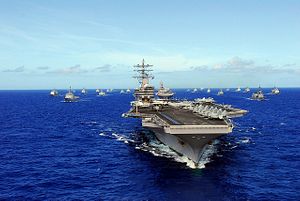This week, Breaking Defense published an interesting piece entitled “What Navy’s New Maritime Strategy Should Say,” co-authored by John F. Lehman and Randy J. Forbes. Lehman served as the U.S. Secretary for the Navy under Ronald Reagan from 1981 to 1987, and Forbes (R-VA) is the hawkish chairman of the House Armed Services Seapower and Projection Forces Subcommittee – an influential body in formulating naval policies. The article deals with the U.S. Navy’s new maritime strategy, to be published today.
It starts off with a predictable yet poorly chosen historical analogy: the 1982 Maritime Strategy and how it inspired the U.S Navy to take the “fight directly to the Soviet Union rather than to consign itself to simply transporting troops to the fight.” This “helped remind the service [the U.S. Navy] of its fighting spirit, but also sent a powerful signal to friend and foe alike that the service remained a force to be reckoned with.” This is one of the usual playbook arguments used by hedgehog analysts suffering from the “Gathering Storm Syndrome” (I wrote about it here and here), and fails on many analytical levels and historical realities.
The authors then go on to emphasize that the strategy will need to contain four key elements in order to be successful. Again, the first one is almost laughably predictable:
“A key element of the 1982 Strategy was signaling America’s renewed commitment to robust naval power to both our adversaries and allies. The new Maritime Strategy must follow a similar path, clearly conveying to states like Russia, Iran and China our determination to maintain sufficient capacity to ensure access to the global sea-lanes, freedom of navigation, and a stable balance in key regions of the globe.”
Whatever happened to Theodore Roosevelt’s “speak softly, and carry a big stick” foreign policy approach? The world’s most powerful navy does not need to signal its resolve and strengths; rather, let the navy’s capabilities and size speak for itself. Furthermore, signaling uncompromising resolve also fails to take into account the opportunity cost of pursuing such a hawkish line at the expense of trust-building mechanisms and maritime cooperation agreements between the countries mentioned above and the United States, which could help reduce tensions.
Perhaps, the authors should heed Margaret Thatcher’s saying that “being powerful is like being a lady. If you have to tell people you are, you aren’t.” Also as George Smiley notes in Tinker Tailor Soldier Spy, fanatics (i.e. defense hawks) are always prone to uncompromising attitudes, yet “the fanatic is always concealing a secret doubt.” Thus, signaling strong resolve may actually have the reverse effect.
However, the article does contain three useful observations. First, the authors note the importance of budget coherence. “The new strategy must provide high-level thinking to inform the Sea Service’s annual budget proposals, which too often appear to be accounting exercises as much as realistic statements of military requirements.”
Second, unlike the White House’s National Security Strategy, the new maritime strategy ought to be a document outlining a specific strategic vision and which, like the 1982 strategy, should offer “specific guidance that could be easily operationalized and implemented far down the chain of command.”
Third, Lehman and Forbes emphasize an holistic approach to strategy formulation and note that “the new Maritime Strategy must include all aspects of American naval power to be successful.” They go on to explain that “the 1982 Strategy spoke not only to the role of the traditional sea services: It considered the role of the Air Force’s maritime aircraft and even attempted to account for the Army’s role in any future maritime conflict.”
Perhaps the authors can be classified as strategic hedgehog-tactical fox hybrid analysts after all?

































